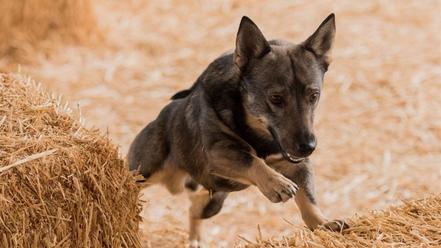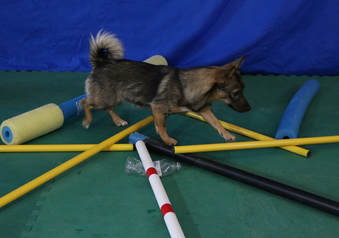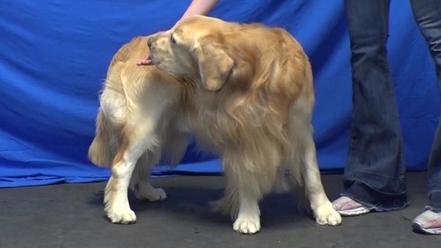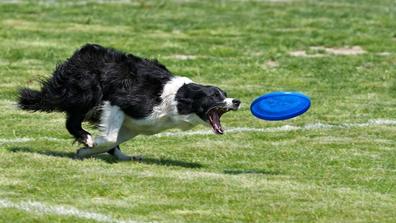
Your dog is an athlete and you are your dog's coach and trainer. But do you really know what happens to your dog’s body during a workout? Just exactly how does exercise make your dog stronger? Having a functional understanding of the process helps tremendously in learning how to build your dog’s workout.
Your dog’s muscles get bigger and stronger in 2 main ways. One way is through improved neuromuscular efficiency and the other is an actual increase in muscle fiber size. The first way consists of the brain calling upon more motor units, which consists of one motor nerve cell and all the muscle fibers it connects to, to participate in a movement. Each muscle has multiple motor units in it, although the exact number varies. The more motor units that are activated the stronger the muscle contraction is. The second way is through muscle cell hypertrophy, or enlargement of the muscle fibers. This is an increase in the cross sectional area, not the length of the muscle cell.
Let’s take a look at the first way that strengthening occurs - through increased efficiency in the neuromuscular system. For every action and movement you or your dog performs, the central nervous system controls it. The brain will decide which muscles to contract, how many muscle fibers to contract, with what intensity to contract at and how often to contract. This is done through the motor units. In essence the brain decides how many motor units in the muscles to activate in order to accomplish the task at hand. If I am trying to lift a gallon jug of milk for example, my brain will determine whether the job will take x number or y number of motor units in my biceps muscle. Ideally, the nervous system tries to recruit just enough to do the job without wasting energy by contracting too many muscle fibers. Most of the time our nervous system does an accurate job but sometimes we are tricked into thinking something is heavy when it is not or vice versa. (Have you ever thought something was heavy and put a lot of effort into moving it only to realize it was actually quite light and then you nearly flung it across the room?) But too little recruitment and we are not able to do the task.
When your dog first begins a formal strength training program, you will see improvements in strength in about 2 weeks mainly because the brain is activating more muscle fibers to participate in the exercises. This is called increased neural recruitment. Eventually the nervous system doesn’t have any more motor units to recruit however and gains in strength will have to come from muscle cell hypertrophy.
Additional strengthening past neural recruitment levels rely on muscle cell hypertrophy, in which the muscle cells actually become larger. How does this happen? It is a complicated process but it starts with a workout. The physiologic stress of resistance training causes micro damage to the contractile proteins in the muscle fibers. Satellite cells that are hanging out near the membranes of the muscle cells are called into action. These satellite cells multiply and fuse into new protein strands or repair the damaged protein strands. The nucleus in these satellite cells then becomes part of the muscle fiber and can now make additional muscle proteins (which are needed for muscle contraction). Production of more contractile proteins within the muscle cells enlarges the overall size of the cell and the increased ability to contract means more strength. So essentially, microtrauma is repaired and protein production is upregulated resulting in a bigger, stronger cell. Additionally, because of the stress of the workout, increased bloodflow to the muscles occurs. This happens by the body actually creating new capillaries to the tissue to support the muscle cells’ needs.
Note that all this repair and rebuild occurs in the recovery phase AFTER the workout. Many factors affect the ability of an individual’s muscles to hypertrophy, including genetics, hormones, and nutrition. But the basic process is the same in everyone.
This process begins when your dog first starts the program but takes time to complete the process and actually see the results of larger muscles. It usually takes several months to see and be able to measure this muscle enlargement. If your dog’s training program is appropriate your dog should experience both forms of strengthening.
Your dog’s muscles get bigger and stronger in 2 main ways. One way is through improved neuromuscular efficiency and the other is an actual increase in muscle fiber size. The first way consists of the brain calling upon more motor units, which consists of one motor nerve cell and all the muscle fibers it connects to, to participate in a movement. Each muscle has multiple motor units in it, although the exact number varies. The more motor units that are activated the stronger the muscle contraction is. The second way is through muscle cell hypertrophy, or enlargement of the muscle fibers. This is an increase in the cross sectional area, not the length of the muscle cell.
Let’s take a look at the first way that strengthening occurs - through increased efficiency in the neuromuscular system. For every action and movement you or your dog performs, the central nervous system controls it. The brain will decide which muscles to contract, how many muscle fibers to contract, with what intensity to contract at and how often to contract. This is done through the motor units. In essence the brain decides how many motor units in the muscles to activate in order to accomplish the task at hand. If I am trying to lift a gallon jug of milk for example, my brain will determine whether the job will take x number or y number of motor units in my biceps muscle. Ideally, the nervous system tries to recruit just enough to do the job without wasting energy by contracting too many muscle fibers. Most of the time our nervous system does an accurate job but sometimes we are tricked into thinking something is heavy when it is not or vice versa. (Have you ever thought something was heavy and put a lot of effort into moving it only to realize it was actually quite light and then you nearly flung it across the room?) But too little recruitment and we are not able to do the task.
When your dog first begins a formal strength training program, you will see improvements in strength in about 2 weeks mainly because the brain is activating more muscle fibers to participate in the exercises. This is called increased neural recruitment. Eventually the nervous system doesn’t have any more motor units to recruit however and gains in strength will have to come from muscle cell hypertrophy.
Additional strengthening past neural recruitment levels rely on muscle cell hypertrophy, in which the muscle cells actually become larger. How does this happen? It is a complicated process but it starts with a workout. The physiologic stress of resistance training causes micro damage to the contractile proteins in the muscle fibers. Satellite cells that are hanging out near the membranes of the muscle cells are called into action. These satellite cells multiply and fuse into new protein strands or repair the damaged protein strands. The nucleus in these satellite cells then becomes part of the muscle fiber and can now make additional muscle proteins (which are needed for muscle contraction). Production of more contractile proteins within the muscle cells enlarges the overall size of the cell and the increased ability to contract means more strength. So essentially, microtrauma is repaired and protein production is upregulated resulting in a bigger, stronger cell. Additionally, because of the stress of the workout, increased bloodflow to the muscles occurs. This happens by the body actually creating new capillaries to the tissue to support the muscle cells’ needs.
Note that all this repair and rebuild occurs in the recovery phase AFTER the workout. Many factors affect the ability of an individual’s muscles to hypertrophy, including genetics, hormones, and nutrition. But the basic process is the same in everyone.
This process begins when your dog first starts the program but takes time to complete the process and actually see the results of larger muscles. It usually takes several months to see and be able to measure this muscle enlargement. If your dog’s training program is appropriate your dog should experience both forms of strengthening.




 RSS Feed
RSS Feed